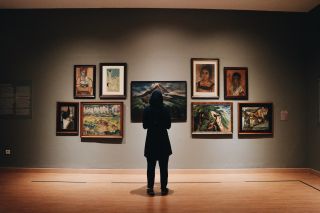Career
Your Brain on Art
There is great similarity in brain processes involved in creating art and experiencing it.
Posted March 7, 2023 Reviewed by Abigail Fagan
Key points
- Psychology of art theories describe art creation and art appreciation as mirror images of each other.
- Neuroscience research shows great similarity in brain regions active during creative production and art viewing.
- Both creative production and art viewing involve brain areas related to object recognition, visual-spatial processing, and personal memory.

The primary author of this post is Dr. Oshin Vartanian, University of Toronto.
Most people share the intuition that the creation and appreciation of art are important aspects of being human. Art moves us emotionally, and it is a source of meaning. We are in awe standing in the Altamira caves admiring paintings made more than 35,000 years ago, and cannot help but wonder about their meaning. Similarly, when we engage with artworks old and new, we are driven to ponder the intentions, ideas, and messages of their creators. What was going on in their brains as they created those artworks, and what goes on in our own brains as we appreciate them? Indeed, philosophers have been asking questions about the value of art for a long time. The theory of aesthetic cognitivism argues that the value of art is not only in its power to touch us emotionally — through delight, amusement, or disgust — but also in its role in facilitating a better understanding of ourselves, the human condition, and moral and spiritual concepts writ large. In other words, as we reflect on art, we might in fact learn more about ourselves or the world.
A few years ago I had the pleasure of visiting the Empirical Visual Aesthetics (EVA) lab at the University of Vienna, which is approximately one mile away from the Kunsthistorisches Museum. The museum collection is truly awe-inspiring, including works by Rembrandt, Raphael and Michelangelo, among others. Critically, however, it also houses one of Vermeer’s well-known masterpieces — The art of painting (also known as The allegory of painting). Seeing a Vermeer is always special. Not only are there a total of 34 paintings firmly attributed to the Dutch master, but they are also dispersed geographically in different museums across the world, with many owning only a single exemplar. For those of us who love his works, there is great anticipation in arriving in a city that happens to include one of his paintings in a local museum. Needless to say, our group headed more or less straight to The art of painting. Much to our delight, this section of the museum was largely deserted, allowing us a good bit of time to engage with the artwork — certainly more than the average 27-29 seconds people spend viewing paintings in a typical visit.
For anyone unfamiliar with this work, it depicts an artist painting a woman, draped in an extraordinarily beautiful rendering of light emanating from a window — a hallmark of Vermeer’s work. The content is very rich in symbolism, allowing for lengthy contemplation of its meaning. Then, something very special happened: I felt a particularly strong connection not just to what is represented visually in the work, but to what its underlying message might be. There is of course no way to verify whether my interpretation of this message corresponded to what Vermeer was hoping to communicate.
This is where Pablo Tinio’s Mirror Model of Art comes in. According to this model, the processes of art-making and art-viewing are inherently connected and correspond to each other in a mirror-reversed fashion. Processes of art creation and art-appreciation operate along three stages. The first stage of art-making — initialization — involves ideation processes for generating and exploring ideas and concepts that motivate the work, typically ending with a basic geometric skeleton that can be developed further. The second stage — expansion and adaptation — involves the development and refinement of the early structure through addition, modification, and deletion of specific elements of the artwork. In the third stage — finalizing — the process involves enhancements and modifications such as fine-tuned refinements of color, texture, and other subtle features that signal the completion of the artwork. These late enhancements are typically applied to the surface layer of the artwork, rather than the structural and geometric underpinning of the work.
In turn, the process of art-appreciation involves movement along these three stages in reverse order. Viewers first perceive and interact with the surface features of the artwork, such as its color, texture, and luminance. Next, in the second stage, memories in relation to the artworks are activated rather automatically, including assessments of its familiarity. This is followed by more deliberate, explicit processing of the artworks in relation to their content, structure, and style. Finally, in the last stage, people interpret the artwork and come to understand it in relation to their current knowledge, past experiences, and the context within which the artwork is experienced. Indeed, if this last stage of processing is successful, then the viewer can be said to have made some contact with the original idea or concept that motivated the work in the creator’s mind, understood via their personal lens.
Researchers in empirical aesthetics and neuroaesthetics — a scientific domain concerned with understanding the neurological bases of aesthetic experiences — are beginning to gain evidence regarding the connection between art creation and art appreciation as described by psychologists of art. Here, it is critical to acknowledge the psychological and environmental context within which artworks are experienced, such as museum settings. In my example described earlier, I entered the Kunsthistorisches Museum primed to engage with The art of painting.
Indeed, Gerry Cupchik and colleagues have shown that unlike ordinary perception which is pragmatic and oriented toward the identification of objects in visual scenes, an aesthetic orientation to perception is geared toward greater emotional openness when engaging with visual stimuli. In an fMRI study to test this idea, participants were instructed to either adopt an aesthetic orientation — which involved approaching the paintings in a subjective and engaged manner to experience the feelings they evoke — or with a pragmatic orientation, which involved approaching the paintings in an objective and detached manner to obtain information about the content of the painting.
The results revealed that the aesthetic orientation was correlated with activation in the bilateral anterior insula — a region of the brain implicated in the experience of emotion. In turn, the pragmatic orientation was correlated with activation in the fusiform gyrus, a region implicated in object perception and recognition. Interestingly, the left lateral prefrontal cortex was engaged when participants adopted the aesthetic orientation, suggesting that some degree of overt control is necessary for switching from ordinary perception to an approach that facilitates aesthetic engagement with artworks. These findings reinforce the strong role that contextual factors can play in support of our interactions with artworks (e.g., it is easier to engage with art in a museum than in a laboratory).
Recently, Delaram Farzanfar and colleagues at the University of Toronto put Tinio’s Mirror Model of Art to test. A key postulate of this model is that early stages of art-making correspond to the late stages of art-appreciation, and conversely, that the late stages of art-appreciation correspond to the early stages of art-making. This “mirroring” hypothesis was tested with a meta-analysis of fMRI studies of creative production and aesthetic appreciation in the visual domain. The advantage of a meta-analysis is that it is a study of multiple existing studies, which can produce more reliable results than any single study. This analysis was focused on participants engaging in creative production or aesthetic appreciation for less than 30 seconds, allowing one to glean a picture of what is happening in the brain in the very early stages of those processes. The results demonstrated that creative production engaged prefrontal regions supporting ideation, whereas aesthetic appreciation engaged ventral visual stream and reward structures underlying perceptual and affective processing.
The results also revealed that creative production and aesthetic appreciation share many of the same underlying neural structures, suggesting commonalities between these two activities. Specifically, both creative production and aesthetic appreciation engaged the parahippocampal gyrus and the fusiform gyrus. Whereas the parahippocampal gyrus is involved in visual-spatial processing and episodic memories (recollection of previous experiences, including the context when they happened, where, and what emotions were associated with them), the fusiform gyrus is involved in the perception and recognition of objects. Artists are inspired by what they see in the world around them and draw on personal experiences to create their work. And viewers perceive art as objects — paintings, sculpture, video — and draw on personal memories in interpreting what they are seeing. Described this way, it is easy to see that neurological and psychological processes point to a tight coupling between the creation and appreciation of visual art.
As noted by Steven Brown in his recent book The Unification of the Arts, creativity can be viewed as the source of cultural variants, whereas aesthetics is the appraisal mechanism for the products of creativity. In this way, aesthetic appreciation becomes the process by which consumers evaluate the appeal of creative products. Next time you’re at the museum, remember that your aesthetic judgments of artworks might matter more than you thought they did.
References
Brown, S. (2022). The unification of the arts. Oxford: Oxford University Press.
Cupchik, G. C., Vartanian, O., Crawley, A., & Mikulis, D. J. (2009). Viewing artworks: contributions of cognitive control and perceptual facilitation to aesthetic experience. Brain and Cognition, 70, 84-91. https://doi.org/10.1016/j.bandc.2009.01.003
Farzanfar, D., Vartanian, O., & Walther, D. (2022, March). Where creative production meets aesthetic appreciation: A meta-analytic test of the Mirror Model of Art in the visual domain using Activation Likelihood Estimation (ALE). Poster presented at the annual meeting of the Society for the Neuroscience of Creativity. Boston, MA.
Goodman, N. (1978). Ways of worldmaking. Indianapolis, IN: Hackett.
Smith, L. F., Smith, J. K., & Tinio, P. P. L. (2017). Time spent viewing art and reading labels. Psychology of Aesthetics, Creativity, and the Arts, 11, 77-85. https://doi.org/10.1037/aca0000049
Tinio, P. P. L. (2013). From artistic creation to aesthetic reception: The mirror model of art. Psychology of Aesthetics, Creativity, and the Arts, 7, 265-275. https://doi.org/10.1037/a0030872
Vartanian, O. (2022). The creative generation and appreciation of artistic artifacts in the visual domain. In L. J. Ball & F. Vallée-Tourangeau (Eds.), Routledge international handbook of creative cognition. New York: Routledge.




